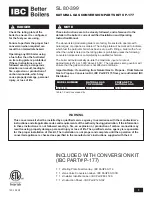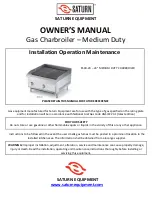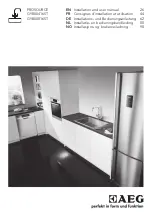
The automatic bleeder is equipped with
shut off screws.
Important! Information on air bleeding
!
Information in this type of box [!] is particularly important for correctly installing
and using the product.
i
Information in this type of box [i] is intended to help ensure that the product
functions optimally.
For the product to work as intended, the system must be
fully bled.
It is extremely important that a basic bleeding of the product is carried out
systematically and carefully.
Bleeding devices must be fitted to the system’s natural high points. A basic
bleeding of the hot water tank can be carried out upon installation by releasing
the safety valve, which must be fitted to the top of the product.
The water must be circulated during bleeding of the various subsystems: the
radiator systems, heat pump system and hot water charging system (to run the
pumps, 3-way valve etc. manually, go into the menu Installer/Service/Function
test). Also move the 3-way valve during the bleeding process. A careful basic
bleeding must be carried out before the system is put into operation and the
heat pump is started.
Tip:
Once basic bleeding is complete: increase the water pressure in the system
temporarily to approx. 2 bar.
• Automatic bleeding valves are included in the package and supplied as
standard for this product. They must be fitted to the top of the product
as shown in the picture.
• Important! Bleed any air remaining in the radiators (elements) and other
parts of the system after it has been in operation for a short time.
Small microbubbles gradually collect in the system’s ‘pockets’, and it can
take quite a long time before all the air is removed from the system. When the
pressure is temporarily increased, any remaining air pockets are compressed
and carried along more easily with the flow of water and can be released into
the ventilation devices.
Tip:
After the air is bled, there may be a drop in system pressure. Having the
system pressure too low increases the risk of noise in the system and of air
being ‘sucked’ in on the suction side of the pump. Keep an eye on the system
pressure. Bear in mind that the system pressure will vary during the year due to
changes in temperature in the heating circuit, which is completely normal.
If ‘gushing’ sounds can be heard from the product, this is a sign of remaining air.
A loss of heating functionality can also be a sign of remaining air.
Summary of Contents for EcoZenith i350 L 1x230V
Page 3: ...162 505 77 1 2020 09 15 Installation and Maintenance Manual CTC EcoZenith i360 ...
Page 127: ...127 CTC EcoZenith i360 ...
Page 128: ......
Page 129: ......
Page 130: ......
Page 131: ......



































